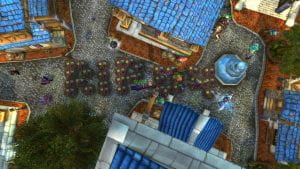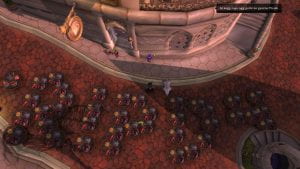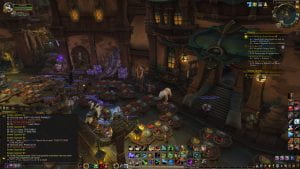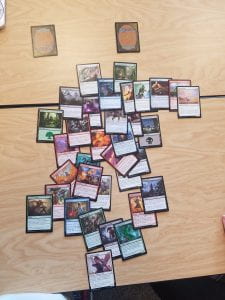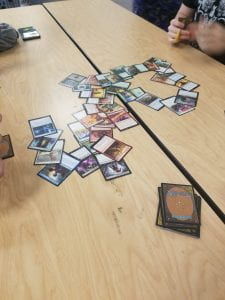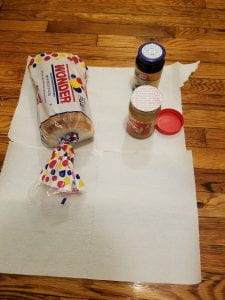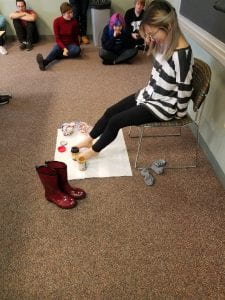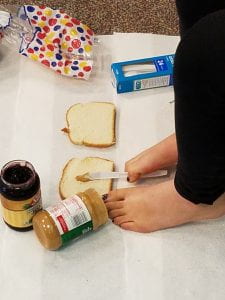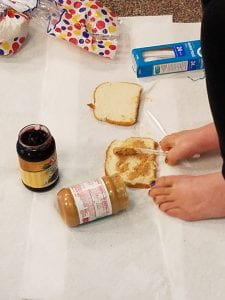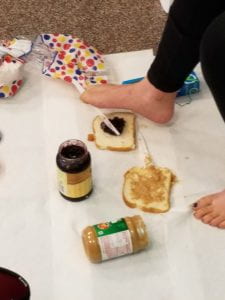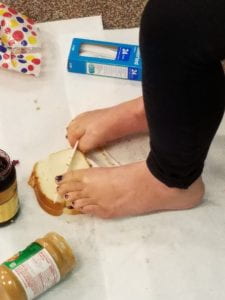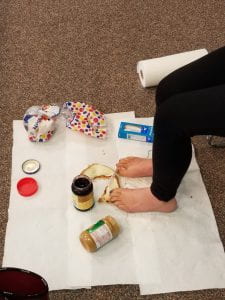LACO: Live Action Coming Out
Artist’s Statement:
I made LACO (Live Action Coming Out) for my expression piece. For me and many other LGBTQ+ people, coming out to family is one of the most stressful parts of life, and it never really ends. You don’t come out to one person and suddenly everyone knows. Every time you meet someone new and they don’t know, at some point you have to tell them.
Despite how people may appear on the outside, there is an internal sense of dread and despair that plagues the coming out process. How do you know when it’s safe to come out to someone? Do you do it before they get too close to you in case it ruins the friendship? Do you do it after you’ve built a rapport and risk losing it all? It’s a constant battle and one that LGBTQ+ people have to fight with constantly throughout their lives.
My intention with this piece was to create a social game that helps to replicate, even if for a single moment, that existential dread that when you come out your world might just fall apart.
My influences were wildly different for my mechanics and my message, but by taking elements of each I was able to craft the experience I wanted. For the mechanics, I took heavy inspiration from hidden roles games such as One Night Ultimate Werewolf, Town of Salem, or Mafia. These games all involve some form of random hidden roles, information gathering, and social interactions between players. As for my thematic inspiration, I drew heavily from my own experiences as a gay man growing up in the South as well as games that explore different parts of LGBTQ+ life such as Dys4ia, Mainichi, and Coming Out Simulator.
These thematic inspirations focused primarily on telling the story of day to day life or a specific story in the life of the creator and I wanted to make the game social. Where these games sought to elicit emotions through carefully crafted stories and writing, I wanted the experience to be more fluid and dynamic. Where these games created a feeling of isolation of the lone player, I wanted to create a feeling of isolation in a group.
I wanted my game mechanics to focus more on the interpersonal interactions. There’s an underlying dread of coming out that pervades every social interaction. Sometimes you have support and everything works out, sometimes you don’t and that world falls apart, and sometimes in your hour of need you run into someone else in the same position as you and you can prop each other up. I feel the social dynamic of turning it into a LARP system with simple mechanics worked well to create these settings. Additionally, by using a full deck of cards, I was able to capture the reality that you don’t know who people truly are until they tell you. In one game you could be gay and have everyone else reject you, or everyone else could support you. Life is random and risky, and I felt my mechanics did a good job of exploring this.
In my most successful play test, the one documented in the pictures, the game ended with the condition that two gay players find each other. This ending brought up a very interesting case where the mother was one of the gay players. This was ultimately a good thing as the system can be used to tell any number of coming out stories. You could tell the story of a teen coming to terms, or the story of a parent finally being able to express themselves while having an established family. Additionally, I like that my system can be re-skinned with new roles or by letting players make their own roles. If you wanted to tell the story of a workplace struggle, create characters for that setting.
The final game artifacts
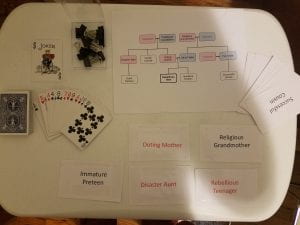
Players split out into their different conversations
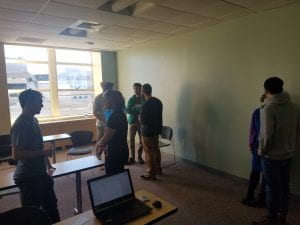
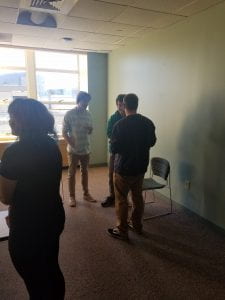

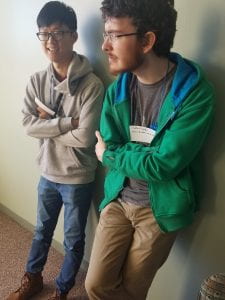
Changes Made Post-Documented Play Test
- The roles now have a family tree that shows how players are related based on their roles.
- Players may create their own roles and rules for how to do so are included.
- Players are now expected to pin their card for public visibility
- The role-playing aspect has been increased in that players are expected to reveal cards in context of the conversation whenever possible.
- The 2nd joker is now part of the 52 card deck, reducing the odds of 2 players having a joker, but still guaranteeing the existence of one in play at a time.
Rules:
Players 5 – 10
Materials
- One standard deck of playing cards with 2 jokers
- Index cards and a way to attach the cards to players (lanyards, yarn, binder clips, clothespins, etc)
- Red and Black markers
- Printouts of the family tree
Setup
- Each player receives 1 colored role card at random or creates their own
- To create a role card, the player does the following:
- Comes up with the quick description for a family member (ex. “Fun Uncle”)
- Draw a card from the deck to determine if they are an Ally (red) or Non-Ally (black)
- Insert your character into the family tree
- To create a role card, the player does the following:
- Remove 1 joker from the deck and shuffle the other one into the deck
- Take the removed joker and (2n-1) cards from the deck where n is the number of players
- Shuffle and deal the cards out
- Each player looks at the 2 cards they were dealt and their public role and determines their team, keeping the information private
-
- Whichever color you have more of in your hand is your team
- Red = Ally, Black = Non-Ally
- If the player has a Joker, they are a closeted gay regardless of their other card or role
Game play
- The game consists of a series of 1 minute rounds
- The number of rounds is equal to the number of players
- Rounds work as follows, with each round lasting 1 minute:
-
- Players split off into smaller groups and have a fun in-character conversation. Players may not reject another player joining their group, after all you are family!
- Each player reveals ONE of their hidden cards to the other people in their group. This MAY be done accompanied by actions or words, or merely shown at the end of the round
- If you are The Gay, then coming out to another player involves revealing the joker. You do not have to reveal the joker if you do not feel comfortable doing so, but coming out to Ally players is the only way to win.
- They are also allowed to say anything about other players provided it is in-character
- If there are 2 Gay players, and both players have come out to each other (regardless of when), the game ends immediately with the “You are not alone” ending.
- If The Gay reveals a joker to you and you are a NON-ALLY, announce loudly that that player is not welcome here and that their “lifestyle choices” are not okay. The game ends immediately. Check “Ending the Game” to determine the winners
- NOTE: You reveal the card to the people you START the round with, though there is nothing stopping you from “eavesdropping” and spotting the card of someone else, though you may not call someone out if they are The Gay and you spot the card this way.
3) After 10 rounds, players reveal their hands
Changes
Ending the Game
There are 4 possible endings:
- “We support you” – The ideal ending for The Gay. This ending is reached if either of the following is true, in which case The Gay has enough allies in the family to feel safe and comfortable and The Gay and Ally players win.
- The 10 rounds end and The Gay has revealed them self to at all of the Ally players
- A NON-ALLY calls The Gay out, and The Gay has revealed them self to at all of the Ally players
- “You are not alone” – The rarest ending, but a reassuring one. This ending is reached if there are 2 Gay players (both players have a joker) and at any point the 2 Gay players came out to each other.
- “Just a Phase” – A common enough excuse for people who experience a rough coming out and who must go back into the closet. In this ending, NON-ALLY players win
- “Maybe next year” – A neutral ending. This it the default ending and is reached if none of the above are triggered. The Gay may have come out to some but otherwise wasn’t comfortable coming out further. That’s okay, you can always tell more people over time. In this ending, no one wins.
Roles
Black
- Strict father – In this house, it’s his rules or nothing.
- Immature Sibling (player’s gender) – Annoying and immature preteen, finds it fun to pester others
- Religious Grandma – Very preachy to the point of annoyance
- “Traditional” Grandpa – Talks about conservative values and how “back in my day…”
- Successful Cousin – Went to college on a full ride, got an internship with THE place to be
Red
- Doting mother – The mother who wants everyone to be okay and happy
- Rebellious Teen (player’s gender) – Edgy and rebellious teenager, likely shops at Hot Topic
- Fun Uncle – The fun uncle, always has a good joke and a fun time
- Disaster Aunt – Where was she last night? Probably not even the same country as 2 nights ago, and even then she isn’t even sure because it’s a tiny bit fuzzy
- Outcast – No one invited them directly, they saw the facebook event and decided to show up after a few years of no contact. Oops

